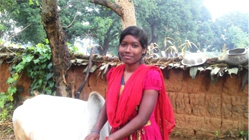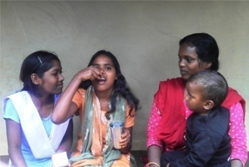Field Stories
Meet a health and wellness messenger providing peer support in India
March 20, 2025
WP_Term Object
(
[term_id] => 49
[name] => Field Stories
[slug] => all-field-stories
[term_group] => 0
[term_taxonomy_id] => 49
[taxonomy] => news-category
[description] => Discover the personal stories of people whose lives have been impacted by better nutrition, and those working tirelessly to deliver it.
[parent] => 0
[count] => 180
[filter] => raw
)
School girl turns mentor for out-of-school girls to help reduce anaemia levels in India
Nikhat Praveen is now a role model and peer guide to out-of-school girls in her village on iron and folic acid supplementation to help address anaemia.
Posted on January 21, 2013


Nikhat, signifies ‘smell’ or ‘flavour’; Praveen means ‘skilled’ or ‘intelligent’.
True to her name, Nikhat Praveen, a 17- year-old Class 11 student of the Lodam Higher Secondary School in the Sai Tangar Toli village bordering the Jashpur district of Chhattisgarh and Jharkhand, India, is now a role model and peer guide to out-of-school girls in her village on iron and folic acid (IFA) supplementation to help address anaemia.
In 2010, the prevalence of anaemia among adolescent girls in the state of Chhattisgarh was at 85 percent among school-going girls and 89 percent among out-of-school girls.
To address this, MI collaborated with the departments of Women and Child Development, Education, and Tribal Development to implement a simple and cost effective intervention.
A single, weekly dose of IFA was administered to more than 95,000 adolescent girls; IFA was given to girls in Class 9 to Class 12 in 424 schools across the state and to 11- to 18-year-old out-of-school girls at 6,832 Anganwadi Centres. This pilot project was implemented in the districts of Raigarh, Jashpur, and Dhamtari in Chhattisgarh in February 2010.


Teachers and peer guides at the schools were provided with training and by March 2011, the program was rolled out across the 424 schools, wherein a weekly dose of IFA was administered to the school girls every Tuesday. Nikhat was one of the school-going girls from the Jashpur district who was a beneficiary of this program.
Initially, Nikhat felt some side effects from the IFA dose but, under close guidance and with the support of her teachers, she continued with the supplements. Soon, she started feeling more energetic.
“It’s a magical tablet that gives strength to do more work. I felt more active and was able to concentrate better on my studies since I started taking these tablets,” she said.
In September 2011, after the school-going program got rolling, training began at the Anganwadi Centres (AWC). Nikhat’s village had 22 out-of-school girls who would come to the AWC to get their weekly IFA dose. However, many girls could not come to the centre because they were out working either in the fields or at a factory to help support their families.
Nikhat discussed her ability to concentrate better after having taken IFA supplements with her neighbour Sunita, an Anganwadi worker at the local AWC. Sunita told Nikhat about the poor attendance of the out-of-school girls at the AWC; Nikhat offered to help. Every Tuesday, Nikhat receives her IFA tablet at school and each Tuesday evening, she helps Sunita bring the out-of-school girls to the AWC.
At the AWC, Sunita and Nikhat do puzzles and look through the flipbook on adolescent anaemia with the girls and Sunita supervises administration of the IFA tablets to them.
Nikhat and Sunita maintain a record of any girls who are unable to come to the AWC and go to their homes to administer the supplements to them there. Nikhat also counsels the girls about the possible side effects of IFA supplements and encourages them not to stop taking them.
Nikhat has been doing this work since she was in Class 9; she is now in class 11. Nikhat’s story is just one example of a girl helping to change not only her life but also the lives of the girls around her, setting in motion a vehicle for positive changes to girls’ health in India.